engine MAZDA MODEL 3 HATCHBACK 2012 (in English) Service Manual
[x] Cancel search | Manufacturer: MAZDA, Model Year: 2012, Model line: MODEL 3 HATCHBACK, Model: MAZDA MODEL 3 HATCHBACK 2012Pages: 525, PDF Size: 5.95 MB
Page 165 of 525
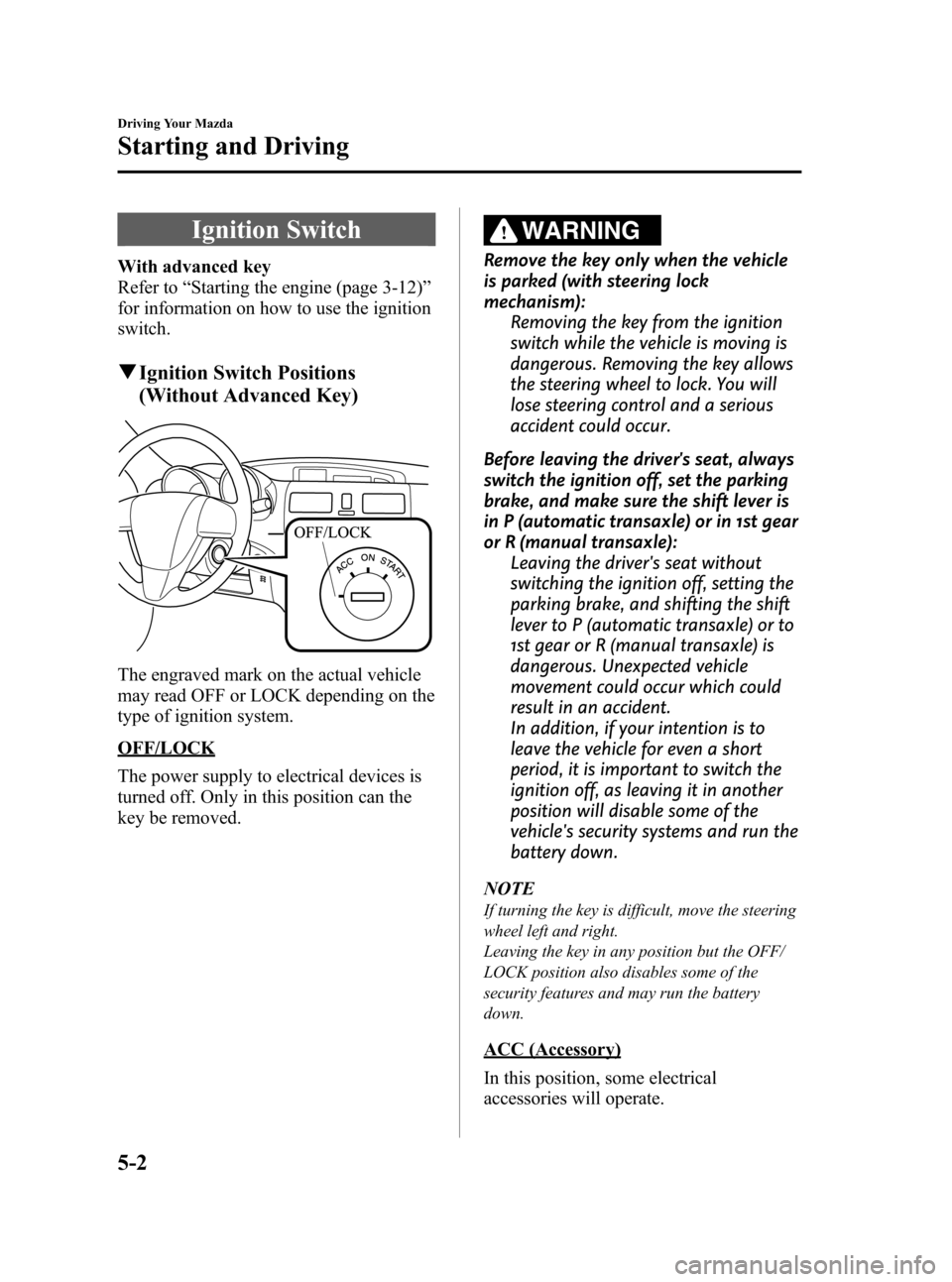
Black plate (164,1)
Ignition Switch
With advanced key
Refer to“Starting the engine (page 3-12) ”
for information on how to use the ignition
switch.
q Ignition Switch Positions
(Without Advanced Key)
The engraved mark on the actual vehicle
may read OFF or LOCK depending on the
type of ignition system.
OFF/LOCK
The power supply to electrical devices is
turned off. Only in this position can the
key be removed.
WARNING
Remove the key only when the vehicle
is parked (with steering lock
mechanism):
Removing the key from the ignition
switch while the vehicle is moving is
dangerous. Removing the key allows
the steering wheel to lock. You will
lose steering control and a serious
accident could occur.
Before leaving the driver's seat, always
switch the ignition off, set the parking
brake, and make sure the shift lever is
in P (automatic transaxle) or in 1st gear
or R (manual transaxle): Leaving the driver's seat without
switching the ignition off, setting the
parking brake, and shifting the shift
lever to P (automatic transaxle) or to
1st gear or R (manual transaxle) is
dangerous. Unexpected vehicle
movement could occur which could
result in an accident.
In addition, if your intention is to
leave the vehicle for even a short
period, it is important to switch the
ignition off, as leaving it in another
position will disable some of the
vehicle's security systems and run the
battery down.
NOTE
If turning the key is difficult, move the steering
wheel left and right.
Leaving the key in any position but the OFF/
LOCK position also disables some of the
security features and may run the battery
down.
ACC (Accessory)
In this position, some electrical
accessories will operate.
5-2
Driving Your Mazda
Starting and Driving
Mazda3_8BY7-EC-11F_Edition1 Page164
Friday, June 17 2011 2:55 PM
Form No.8BY7-EC-11F
Page 166 of 525
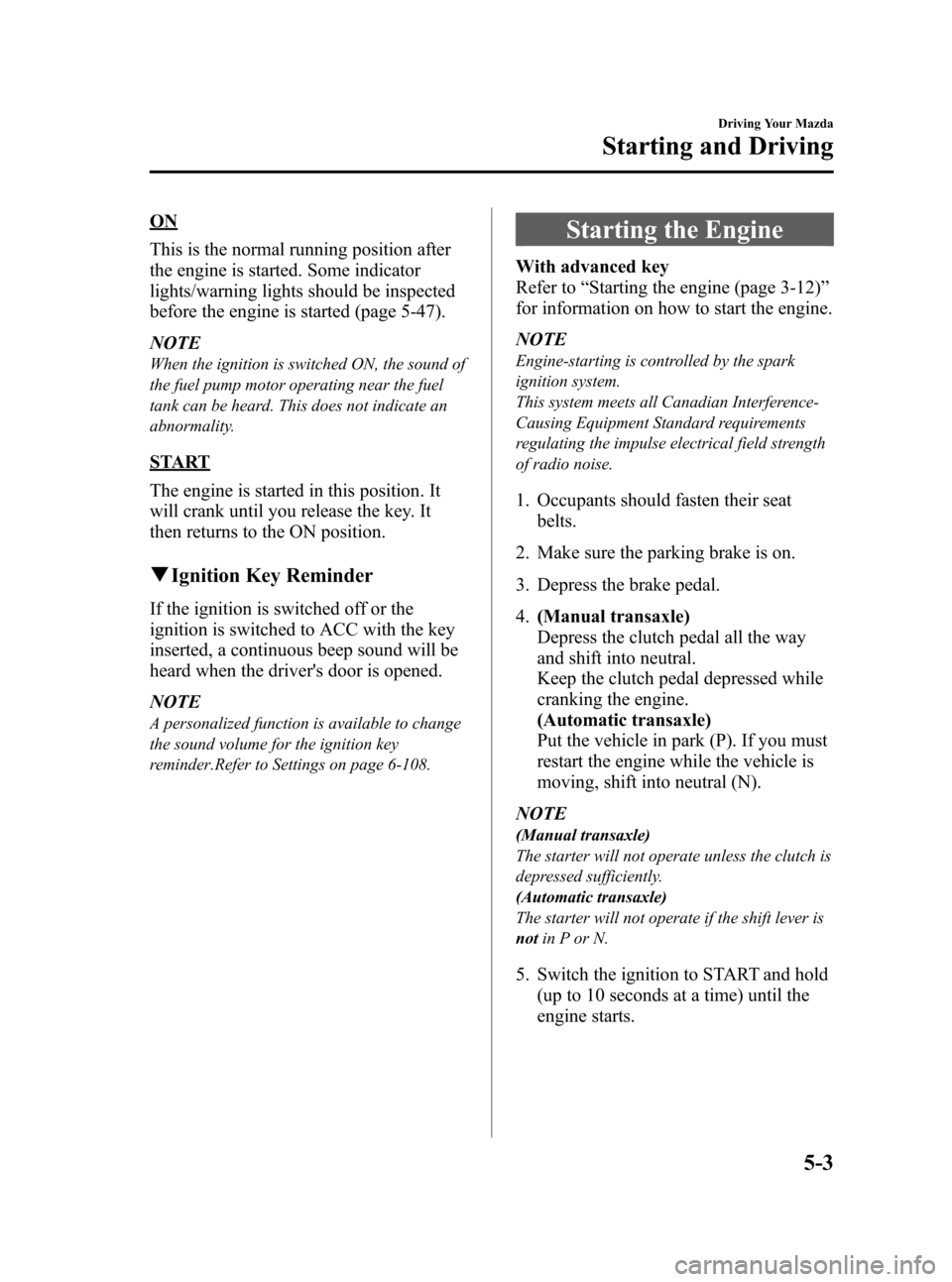
Black plate (165,1)
ON
This is the normal running position after
the engine is started. Some indicator
lights/warning lights should be inspected
before the engine is started (page 5-47).
NOTE
When the ignition is switched ON, the sound of
the fuel pump motor operating near the fuel
tank can be heard. This does not indicate an
abnormality.
START
The engine is started in this position. It
will crank until you release the key. It
then returns to the ON position.
qIgnition Key Reminder
If the ignition is switched off or the
ignition is switched to ACC with the key
inserted, a continuous beep sound will be
heard when the driver's door is opened.
NOTE
A personalized function is available to change
the sound volume for the ignition key
reminder.Refer to Settings on page 6-108.
Starting the Engine
With advanced key
Refer to “Starting the engine (page 3-12) ”
for information on how to start the engine.
NOTE
Engine-starting is controlled by the spark
ignition system.
This system meets all Canadian Interference-
Causing Equipment Standard requirements
regulating the impulse electrical field strength
of radio noise.
1. Occupants should fasten their seat
belts.
2. Make sure the parking brake is on.
3. Depress the brake pedal.
4. (Manual transaxle)
Depress the clutch pedal all the way
and shift into neutral.
Keep the clutch pedal depressed while
cranking the engine.
(Automatic transaxle)
Put the vehicle in park (P). If you must
restart the engine while the vehicle is
moving, shift into neutral (N).
NOTE
(Manual transaxle)
The starter will not operate unless the clutch is
depressed sufficiently.
(Automatic transaxle)
The starter will not operate if the shift lever is
not in P or N.
5. Switch the ignition to START and hold
(up to 10 seconds at a time) until the
engine starts.
Driving Your Mazda
Starting and Driving
5-3
Mazda3_8BY7-EC-11F_Edition1 Page165
Friday, June 17 2011 2:55 PM
Form No.8BY7-EC-11F
Page 167 of 525
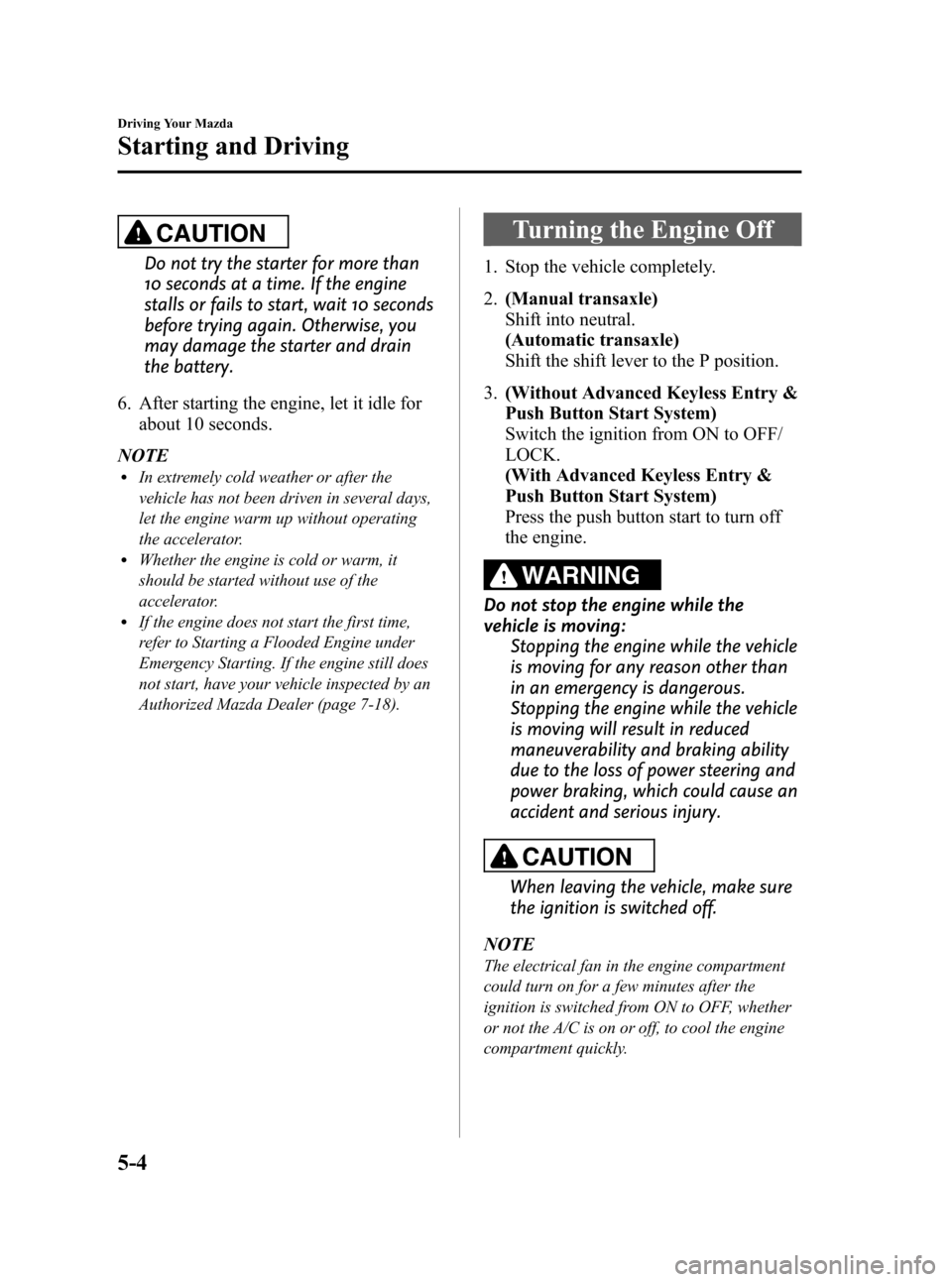
Black plate (166,1)
CAUTION
Do not try the starter for more than
10 seconds at a time. If the engine
stalls or fails to start, wait 10 seconds
before trying again. Otherwise, you
may damage the starter and drain
the battery.
6. After starting the engine, let it idle for about 10 seconds.
NOTE
lIn extremely cold weather or after the
vehicle has not been driven in several days,
let the engine warm up without operating
the accelerator.
lWhether the engine is cold or warm, it
should be started without use of the
accelerator.
lIf the engine does not start the first time,
refer to Starting a Flooded Engine under
Emergency Starting. If the engine still does
not start, have your vehicle inspected by an
Authorized Mazda Dealer (page 7-18).
Turning the Engine Off
1. Stop the vehicle completely.
2. (Manual transaxle)
Shift into neutral.
(Automatic transaxle)
Shift the shift lever to the P position.
3. (Without Advanced Keyless Entry &
Push Button Start System)
Switch the ignition from ON to OFF/
LOCK.
(With Advanced Keyless Entry &
Push Button Start System)
Press the push button start to turn off
the engine.
WARNING
Do not stop the engine while the
vehicle is moving:
Stopping the engine while the vehicle
is moving for any reason other than
in an emergency is dangerous.
Stopping the engine while the vehicle
is moving will result in reduced
maneuverability and braking ability
due to the loss of power steering and
power braking, which could cause an
accident and serious injury.
CAUTION
When leaving the vehicle, make sure
the ignition is switched off.
NOTE
The electrical fan in the engine compartment
could turn on for a few minutes after the
ignition is switched from ON to OFF, whether
or not the A/C is on or off, to cool the engine
compartment quickly.
5-4
Driving Your Mazda
Starting and Driving
Mazda3_8BY7-EC-11F_Edition1 Page166
Friday, June 17 2011 2:55 PM
Form No.8BY7-EC-11F
Page 168 of 525
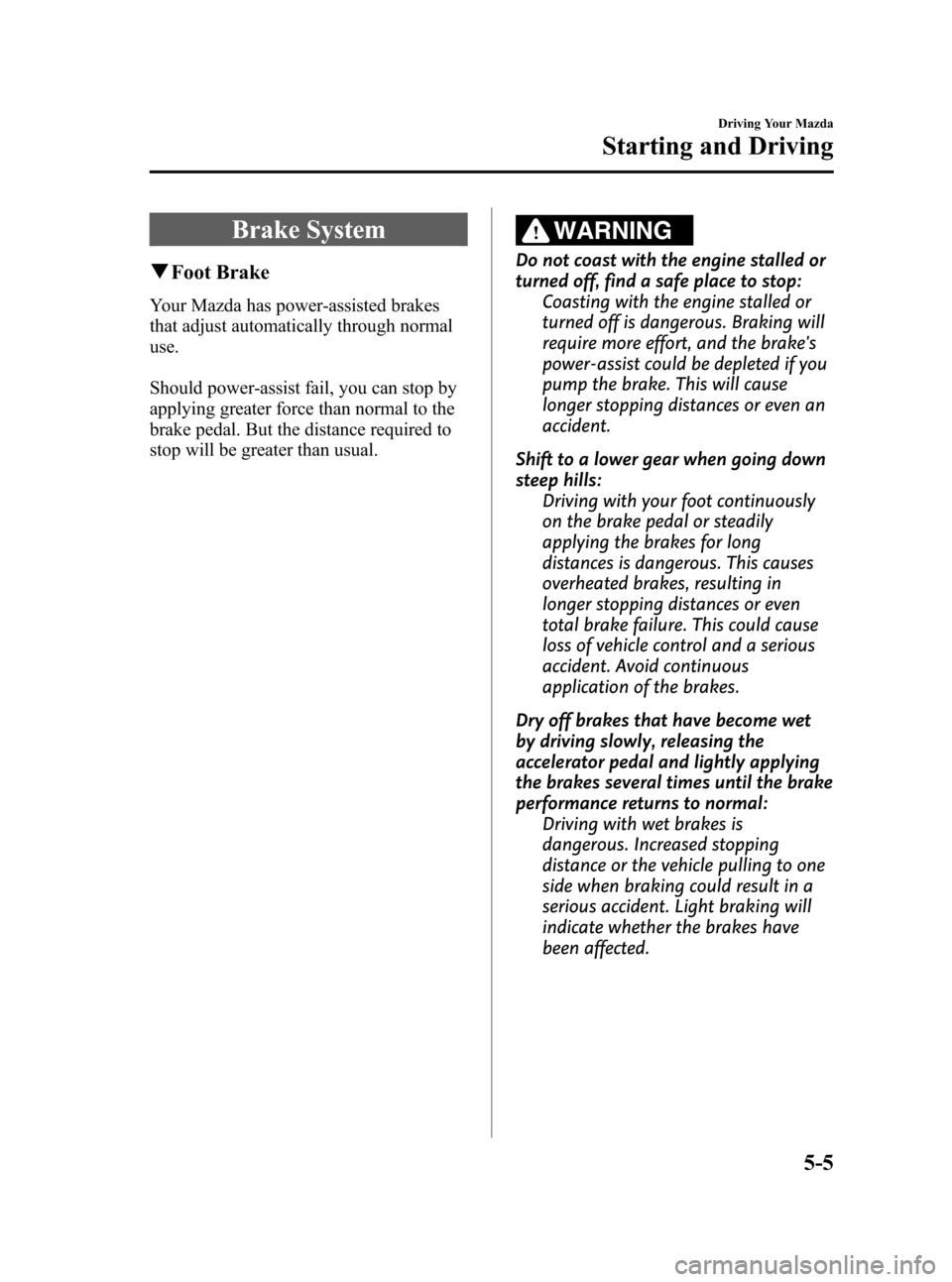
Black plate (167,1)
Brake System
qFoot Brake
Your Mazda has power-assisted brakes
that adjust automatically through normal
use.
Should power-assist fail, you can stop by
applying greater force than normal to the
brake pedal. But the distance required to
stop will be greater than usual.
WARNING
Do not coast with the engine stalled or
turned off, find a safe place to stop:
Coasting with the engine stalled or
turned off is dangerous. Braking will
require more effort, and the brake's
power-assist could be depleted if you
pump the brake. This will cause
longer stopping distances or even an
accident.
Shift to a lower gear when going down
steep hills: Driving with your foot continuously
on the brake pedal or steadily
applying the brakes for long
distances is dangerous. This causes
overheated brakes, resulting in
longer stopping distances or even
total brake failure. This could cause
loss of vehicle control and a serious
accident. Avoid continuous
application of the brakes.
Dry off brakes that have become wet
by driving slowly, releasing the
accelerator pedal and lightly applying
the brakes several times until the brake
performance returns to normal: Driving with wet brakes is
dangerous. Increased stopping
distance or the vehicle pulling to one
side when braking could result in a
serious accident. Light braking will
indicate whether the brakes have
been affected.
Driving Your Mazda
Starting and Driving
5-5
Mazda3_8BY7-EC-11F_Edition1 Page167
Friday, June 17 2011 2:55 PM
Form No.8BY7-EC-11F
Page 170 of 525
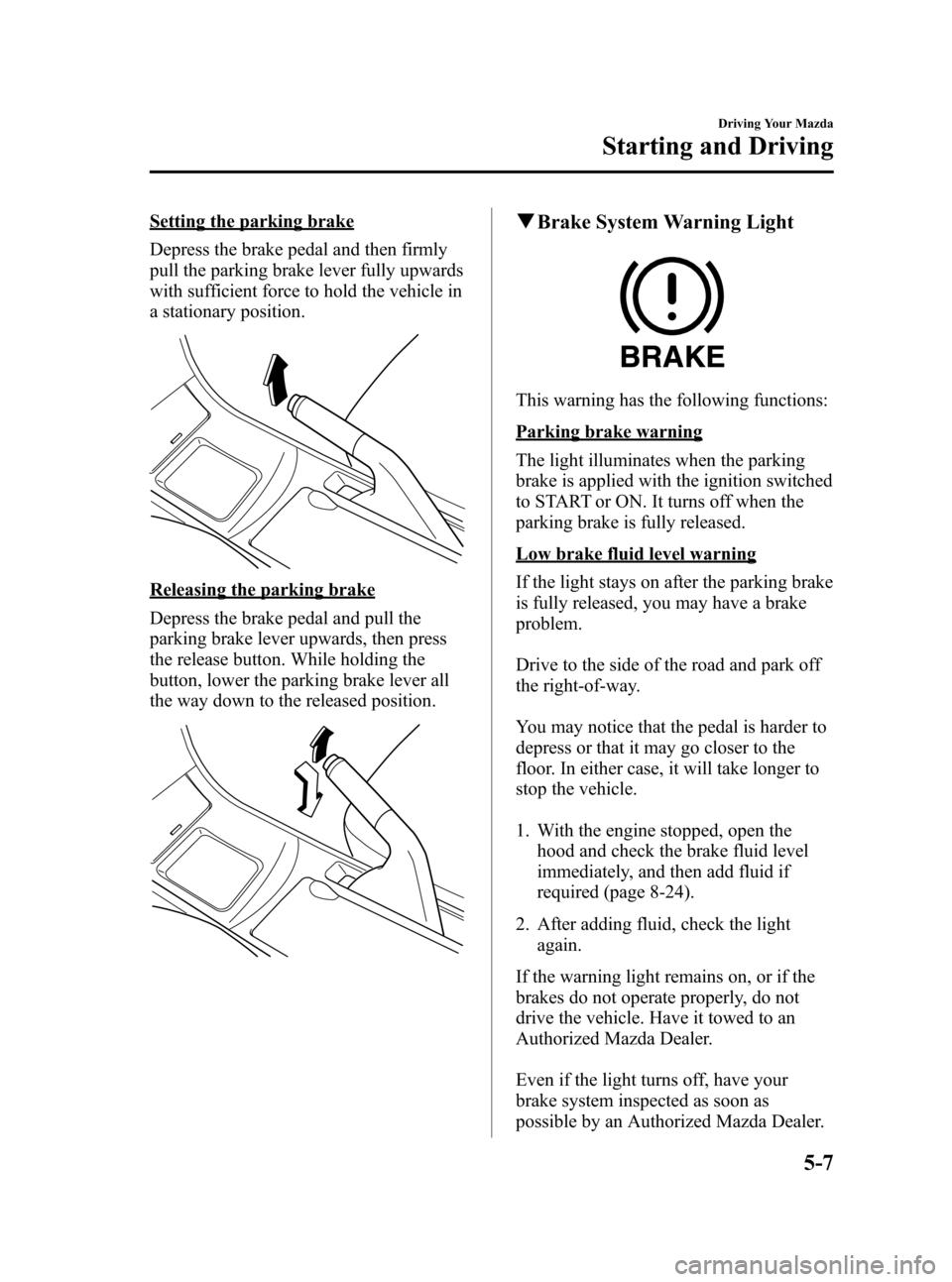
Black plate (169,1)
Setting the parking brake
Depress the brake pedal and then firmly
pull the parking brake lever fully upwards
with sufficient force to hold the vehicle in
a stationary position.
Releasing the parking brake
Depress the brake pedal and pull the
parking brake lever upwards, then press
the release button. While holding the
button, lower the parking brake lever all
the way down to the released position.
qBrake System Warning Light
This warning has the following functions:
Parking brake warning
The light illuminates when the parking
brake is applied with the ignition switched
to START or ON. It turns off when the
parking brake is fully released.
Low brake fluid level warning
If the light stays on after the parking brake
is fully released, you may have a brake
problem.
Drive to the side of the road and park off
the right-of-way.
You may notice that the pedal is harder to
depress or that it may go closer to the
floor. In either case, it will take longer to
stop the vehicle.
1. With the engine stopped, open the
hood and check the brake fluid level
immediately, and then add fluid if
required (page 8-24).
2. After adding fluid, check the light again.
If the warning light remains on, or if the
brakes do not operate properly, do not
drive the vehicle. Have it towed to an
Authorized Mazda Dealer.
Even if the light turns off, have your
brake system inspected as soon as
possible by an Authorized Mazda Dealer.
Driving Your Mazda
Starting and Driving
5-7
Mazda3_8BY7-EC-11F_Edition1 Page169
Friday, June 17 2011 2:55 PM
Form No.8BY7-EC-11F
Page 171 of 525
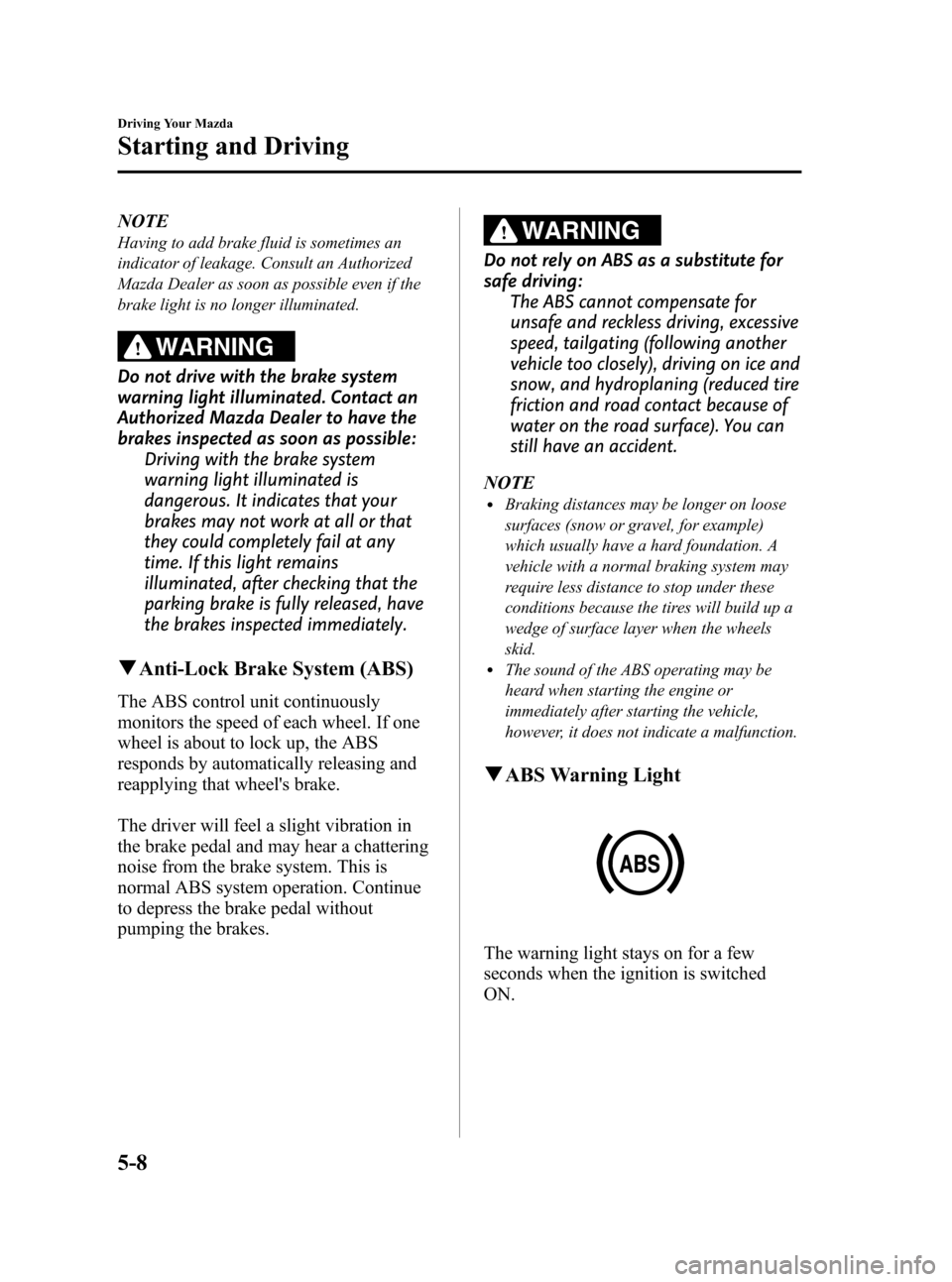
Black plate (170,1)
NOTE
Having to add brake fluid is sometimes an
indicator of leakage. Consult an Authorized
Mazda Dealer as soon as possible even if the
brake light is no longer illuminated.
WARNING
Do not drive with the brake system
warning light illuminated. Contact an
Authorized Mazda Dealer to have the
brakes inspected as soon as possible:Driving with the brake system
warning light illuminated is
dangerous. It indicates that your
brakes may not work at all or that
they could completely fail at any
time. If this light remains
illuminated, after checking that the
parking brake is fully released, have
the brakes inspected immediately.
qAnti-Lock Brake System (ABS)
The ABS control unit continuously
monitors the speed of each wheel. If one
wheel is about to lock up, the ABS
responds by automatically releasing and
reapplying that wheel's brake.
The driver will feel a slight vibration in
the brake pedal and may hear a chattering
noise from the brake system. This is
normal ABS system operation. Continue
to depress the brake pedal without
pumping the brakes.
WARNING
Do not rely on ABS as a substitute for
safe driving:
The ABS cannot compensate for
unsafe and reckless driving, excessive
speed, tailgating (following another
vehicle too closely), driving on ice and
snow, and hydroplaning (reduced tire
friction and road contact because of
water on the road surface). You can
still have an accident.
NOTE
lBraking distances may be longer on loose
surfaces (snow or gravel, for example)
which usually have a hard foundation. A
vehicle with a normal braking system may
require less distance to stop under these
conditions because the tires will build up a
wedge of surface layer when the wheels
skid.
lThe sound of the ABS operating may be
heard when starting the engine or
immediately after starting the vehicle,
however, it does not indicate a malfunction.
q ABS Warning Light
The warning light stays on for a few
seconds when the ignition is switched
ON.
5-8
Driving Your Mazda
Starting and Driving
Mazda3_8BY7-EC-11F_Edition1 Page170
Friday, June 17 2011 2:55 PM
Form No.8BY7-EC-11F
Page 172 of 525
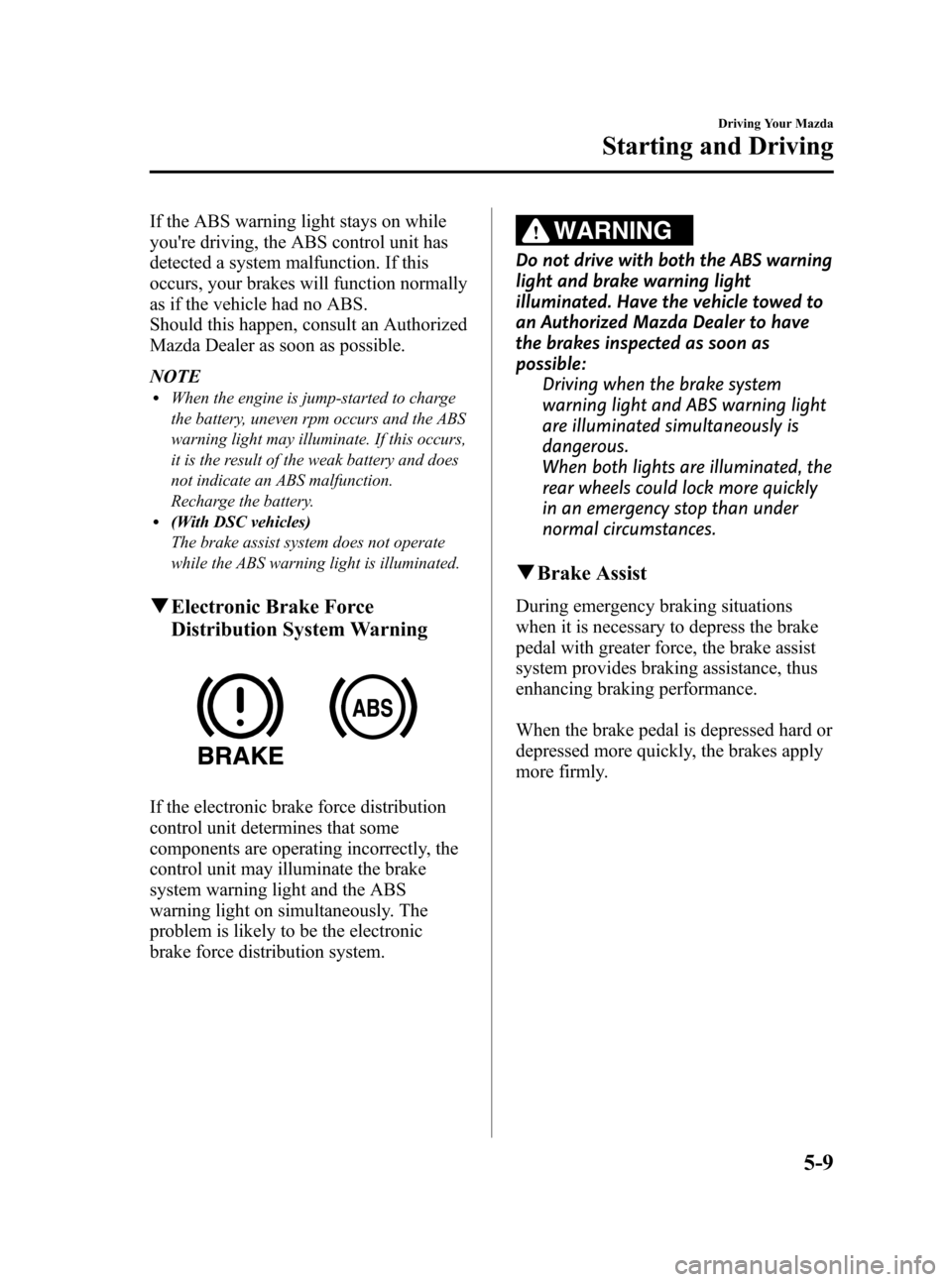
Black plate (171,1)
If the ABS warning light stays on while
you're driving, the ABS control unit has
detected a system malfunction. If this
occurs, your brakes will function normally
as if the vehicle had no ABS.
Should this happen, consult an Authorized
Mazda Dealer as soon as possible.
NOTE
lWhen the engine is jump-started to charge
the battery, uneven rpm occurs and the ABS
warning light may illuminate. If this occurs,
it is the result of the weak battery and does
not indicate an ABS malfunction.
Recharge the battery.
l(With DSC vehicles)
The brake assist system does not operate
while the ABS warning light is illuminated.
qElectronic Brake Force
Distribution System Warning
If the electronic brake force distribution
control unit determines that some
components are operating incorrectly, the
control unit may illuminate the brake
system warning light and the ABS
warning light on simultaneously. The
problem is likely to be the electronic
brake force distribution system.
WARNING
Do not drive with both the ABS warning
light and brake warning light
illuminated. Have the vehicle towed to
an Authorized Mazda Dealer to have
the brakes inspected as soon as
possible:
Driving when the brake system
warning light and ABS warning light
are illuminated simultaneously is
dangerous.
When both lights are illuminated, the
rear wheels could lock more quickly
in an emergency stop than under
normal circumstances.
qBrake Assist
During emergency braking situations
when it is necessary to depress the brake
pedal with greater force, the brake assist
system provides braking assistance, thus
enhancing braking performance.
When the brake pedal is depressed hard or
depressed more quickly, the brakes apply
more firmly.
Driving Your Mazda
Starting and Driving
5-9
Mazda3_8BY7-EC-11F_Edition1 Page171
Friday, June 17 2011 2:55 PM
Form No.8BY7-EC-11F
Page 174 of 525
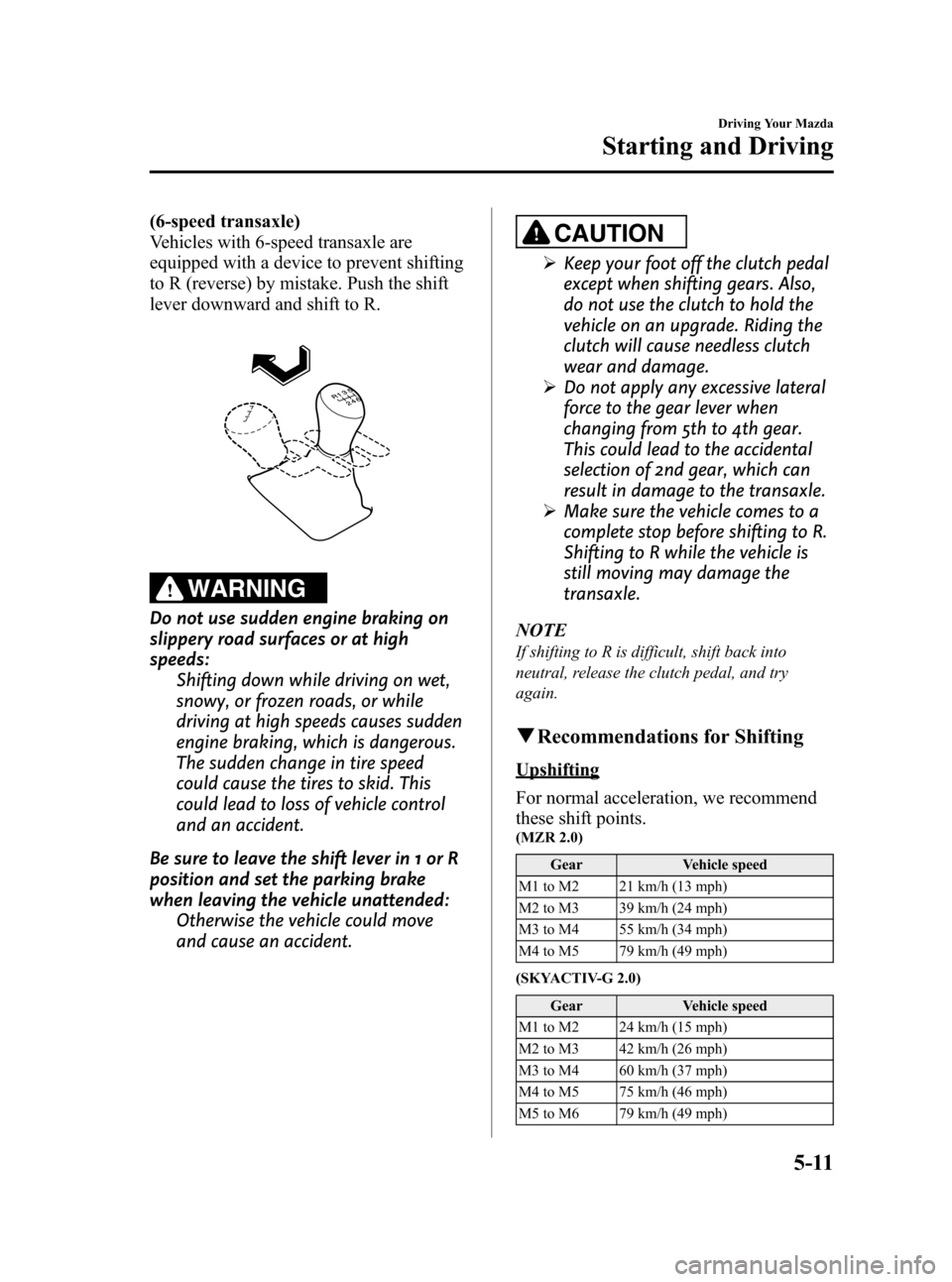
Black plate (173,1)
(6-speed transaxle)
Vehicles with 6-speed transaxle are
equipped with a device to prevent shifting
to R (reverse) by mistake. Push the shift
lever downward and shift to R.
WARNING
Do not use sudden engine braking on
slippery road surfaces or at high
speeds:Shifting down while driving on wet,
snowy, or frozen roads, or while
driving at high speeds causes sudden
engine braking, which is dangerous.
The sudden change in tire speed
could cause the tires to skid. This
could lead to loss of vehicle control
and an accident.
Be sure to leave the shift lever in 1 or R
position and set the parking brake
when leaving the vehicle unattended: Otherwise the vehicle could move
and cause an accident.
CAUTION
ØKeep your foot off the clutch pedal
except when shifting gears. Also,
do not use the clutch to hold the
vehicle on an upgrade. Riding the
clutch will cause needless clutch
wear and damage.
Ø Do not apply any excessive lateral
force to the gear lever when
changing from 5th to 4th gear.
This could lead to the accidental
selection of 2nd gear, which can
result in damage to the transaxle.
Ø Make sure the vehicle comes to a
complete stop before shifting to R.
Shifting to R while the vehicle is
still moving may damage the
transaxle.
NOTE
If shifting to R is difficult, shift back into
neutral, release the clutch pedal, and try
again.
q Recommendations for Shifting
Upshifting
For normal acceleration, we recommend
these shift points.
(MZR 2.0)
Gear Vehicle speed
M1 to M2 21 km/h (13 mph)
M2 to M3 39 km/h (24 mph)
M3 to M4 55 km/h (34 mph)
M4 to M5 79 km/h (49 mph)
(SKYACTIV-G 2.0) Gear Vehicle speed
M1 to M2 24 km/h (15 mph)
M2 to M3 42 km/h (26 mph)
M3 to M4 60 km/h (37 mph)
M4 to M5 75 km/h (46 mph)
M5 to M6 79 km/h (49 mph)
Driving Your Mazda
Starting and Driving
5-11
Mazda3_8BY7-EC-11F_Edition1 Page173
Friday, June 17 2011 2:55 PM
Form No.8BY7-EC-11F
Page 175 of 525
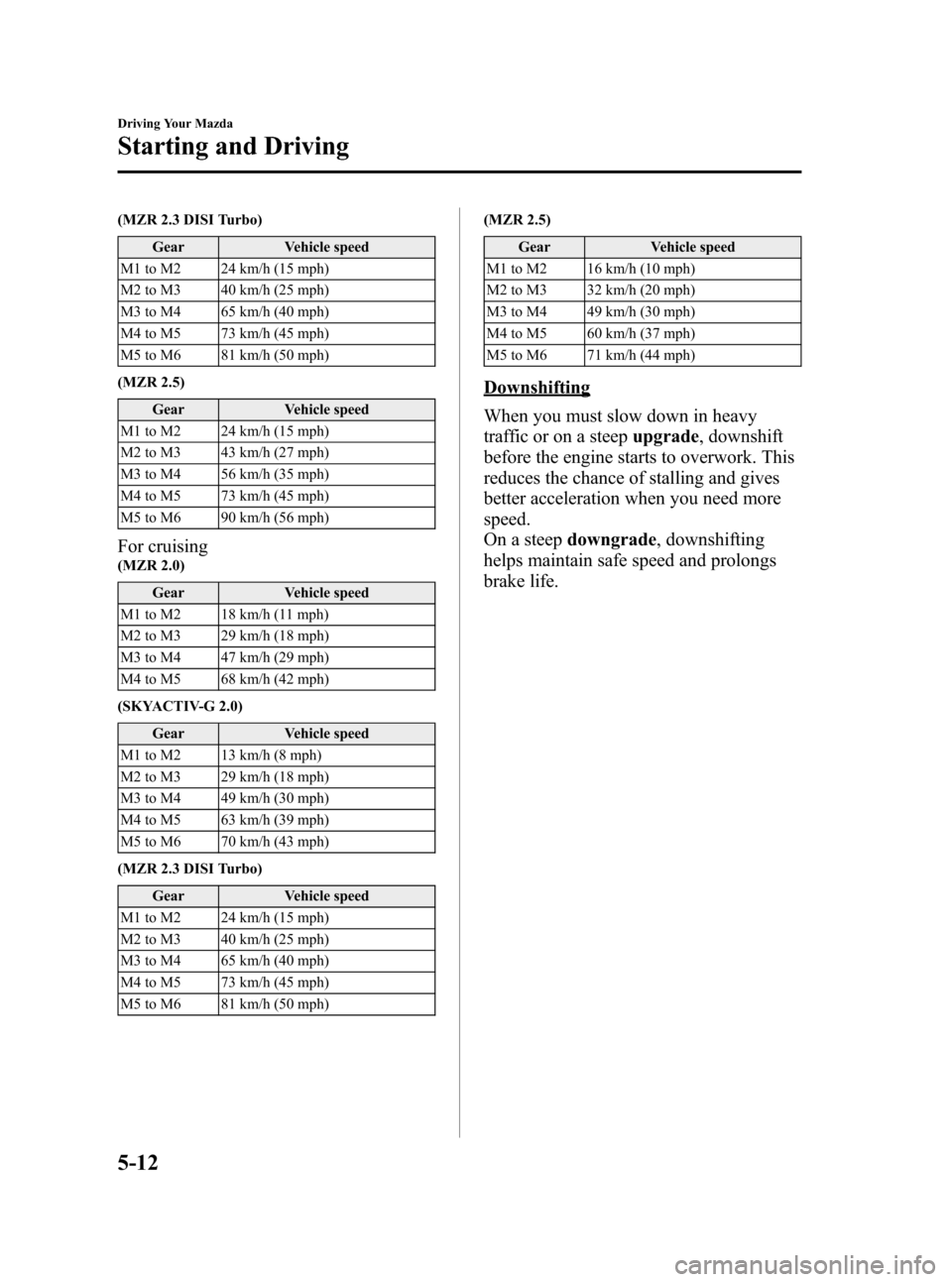
Black plate (174,1)
(MZR 2.3 DISI Turbo)Gear Vehicle speed
M1 to M2 24 km/h (15 mph)
M2 to M3 40 km/h (25 mph)
M3 to M4 65 km/h (40 mph)
M4 to M5 73 km/h (45 mph)
M5 to M6 81 km/h (50 mph)
(MZR 2.5)
Gear Vehicle speed
M1 to M2 24 km/h (15 mph)
M2 to M3 43 km/h (27 mph)
M3 to M4 56 km/h (35 mph)
M4 to M5 73 km/h (45 mph)
M5 to M6 90 km/h (56 mph)
For cruising(MZR 2.0)
Gear Vehicle speed
M1 to M2 18 km/h (11 mph)
M2 to M3 29 km/h (18 mph)
M3 to M4 47 km/h (29 mph)
M4 to M5 68 km/h (42 mph)
(SKYACTIV-G 2.0) Gear Vehicle speed
M1 to M2 13 km/h (8 mph)
M2 to M3 29 km/h (18 mph)
M3 to M4 49 km/h (30 mph)
M4 to M5 63 km/h (39 mph)
M5 to M6 70 km/h (43 mph)
(MZR 2.3 DISI Turbo) Gear Vehicle speed
M1 to M2 24 km/h (15 mph)
M2 to M3 40 km/h (25 mph)
M3 to M4 65 km/h (40 mph)
M4 to M5 73 km/h (45 mph)
M5 to M6 81 km/h (50 mph) (MZR 2.5)
Gear Vehicle speed
M1 to M2 16 km/h (10 mph)
M2 to M3 32 km/h (20 mph)
M3 to M4 49 km/h (30 mph)
M4 to M5 60 km/h (37 mph)
M5 to M6 71 km/h (44 mph)
Downshifting
When you must slow down in heavy
traffic or on a steep upgrade, downshift
before the engine starts to overwork. This
reduces the chance of stalling and gives
better acceleration when you need more
speed.
On a steep downgrade , downshifting
helps maintain safe speed and prolongs
brake life.
5-12
Driving Your Mazda
Starting and Driving
Mazda3_8BY7-EC-11F_Edition1 Page174
Friday, June 17 2011 2:55 PM
Form No.8BY7-EC-11F
Page 176 of 525
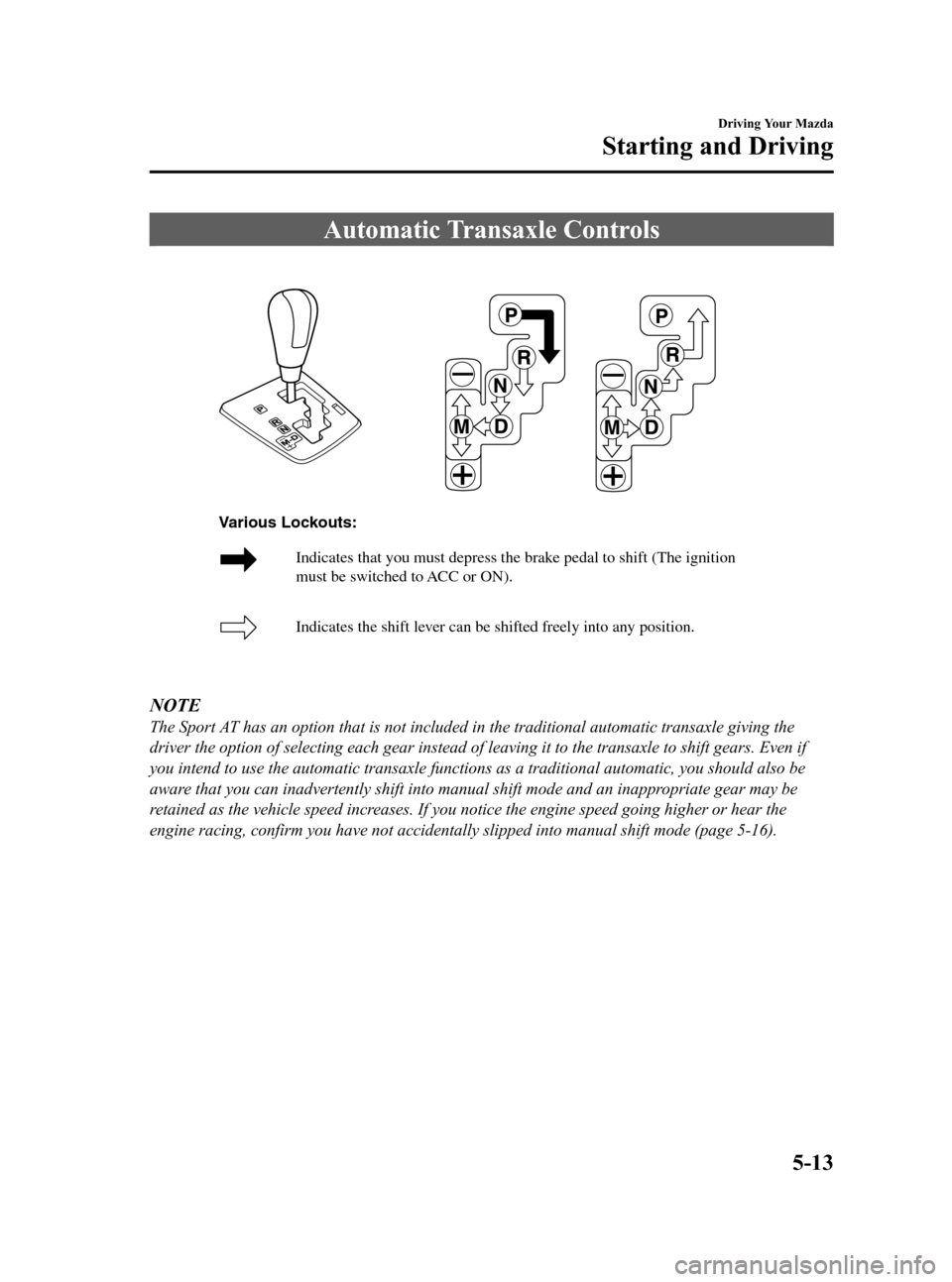
Black plate (175,1)
Automatic Transaxle Controls
Indicates that you must depress the brake pedal to shift (The ignition
must be switched to ACC or ON).
Indicates the shift lever can be shifted freely into any position.
Various Lockouts:
NOTE
The Sport AT has an option that is not included in the traditional automatic transaxle giving the
driver the option of selecting each gear instead of leaving it to the transaxle to shift gears. Even if
you intend to use the automatic transaxle functions as a traditional automatic, you should also be
aware that you can inadvertently shift into manual shift mode and an inappropriate gear may be
retained as the vehicle speed increases. If you notice the engine speed going higher or hear the
engine racing, confirm you have not accidentally slipped into manual shift mode (page 5-16).
Driving Your Mazda
Starting and Driving
5-13
Mazda3_8BY7-EC-11F_Edition1 Page175
Friday, June 17 2011 2:55 PM
Form No.8BY7-EC-11F